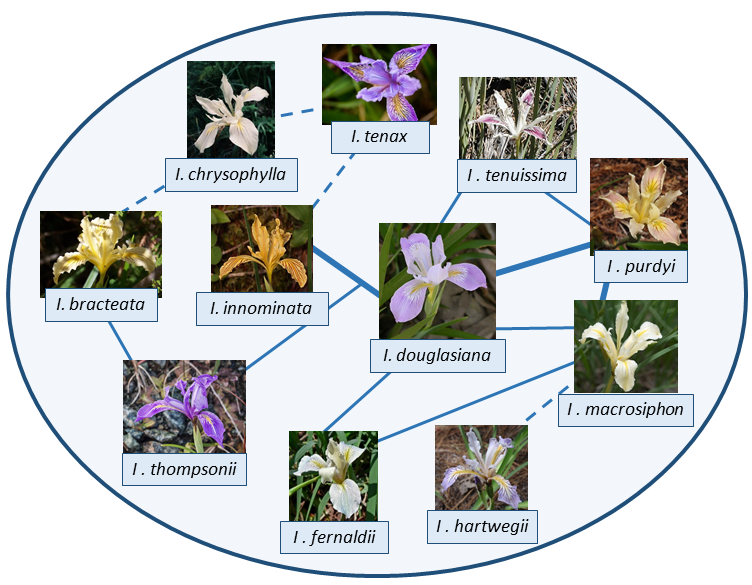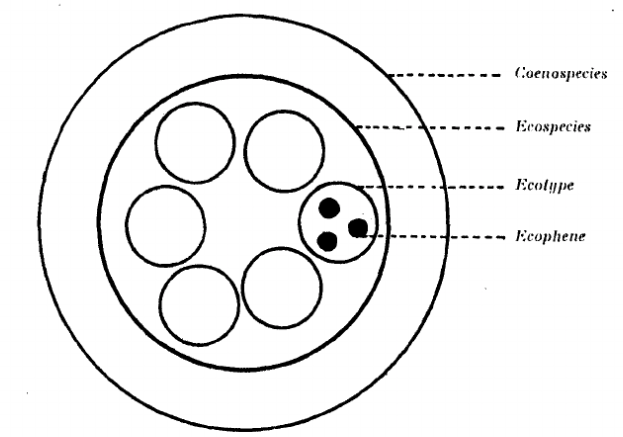Syngameon on:
[Wikipedia]
[Google]
[Amazon]
Syngameon refers to groups of  The term syngameon comes from the root word ''syngamy'' coined by
The term syngameon comes from the root word ''syngamy'' coined by 
taxa
In biology, a taxon (back-formation from ''taxonomy''; : taxa) is a group of one or more populations of an organism or organisms seen by taxonomists to form a unit. Although neither is required, a taxon is usually known by a particular name and ...
that frequently engage in natural hybridization and lack strong reproductive barriers that prevent interbreeding. Syngameons are more common in plants than animals, with approximately 25% of plant species and 10% of animal species producing natural hybrids. The most well known syngameons include irises of the California Pacific Coast and white oak
''Quercus'' subgenus ''Quercus'' is one of the two subgenera into which the genus ''Quercus'' was divided in a 2017 classification (the other being subgenus ''Cerris''). It contains about 190 species divided among five sections. It may be calle ...
s of the Eastern United States. Hybridization within a syngameon is typically not equally distributed among species and few species often dominate patterns of hybridization.
 The term syngameon comes from the root word ''syngamy'' coined by
The term syngameon comes from the root word ''syngamy'' coined by Edward Bagnall Poulton
Sir Edward Bagnall Poulton, FRS HFRSE FLS (27 January 1856 – 20 November 1943) was a British evolutionary biologist, a lifelong advocate of natural selection through a period in which many scientists such as Reginald Punnett doubted its ...
to define groups that freely interbreed
In biology, a hybrid is the offspring resulting from combining the qualities of two organisms of different variety (botany), varieties, subspecies, species or genus, genera through sexual reproduction. Generally, it means that each cell has gene ...
. He also coined the word ''asyngamy'' referring to groups that do not freely interbreed (with the substantive noun forms ''Syngamy'' and ''Asyngamy''). The term syngameon was first used by Johannes Paulus Lotsy
Johannes Paulus Lotsy or Jan Paulus Lotsy (11 April 1867 – 17 November 1931) was a Dutch botanist, specializing in evolution and heredity. He promoted the idea of evolution being driven by hybridization.
Career
Lotsy was born into a wealthy ...
, who used it to describe a habitually interbreeding community that was reproductively isolated from other habitually interbreeding communities. Syngameon was used interchangeably with the term ''species
A species () is often defined as the largest group of organisms in which any two individuals of the appropriate sexes or mating types can produce fertile offspring, typically by sexual reproduction. It is the basic unit of Taxonomy (biology), ...
'' to describe groups of closely related individuals that interbreed to varying degrees. A more specific definition of syngameon has been given to groups of taxa that frequently engage in natural hybridization and lack strong morphological differences that could be used to define them. Taxa in syngameons may have separate species names, but evolutionary biologists
Evolutionary biology is the subfield of biology that studies the evolutionary processes such as natural selection, common descent, and speciation that produced the diversity of life on Earth. In the 1930s, the discipline of evolutionary bi ...
often suggest they should be treated as a single species. Variation among species within a syngameon can be due to a number of factors related to their biogeography
Biogeography is the study of the species distribution, distribution of species and ecosystems in geography, geographic space and through evolutionary history of life, geological time. Organisms and biological community (ecology), communities o ...
, ecology
Ecology () is the natural science of the relationships among living organisms and their Natural environment, environment. Ecology considers organisms at the individual, population, community (ecology), community, ecosystem, and biosphere lev ...
, phylogeny
A phylogenetic tree or phylogeny is a graphical representation which shows the evolutionary history between a set of species or Taxon, taxa during a specific time.Felsenstein J. (2004). ''Inferring Phylogenies'' Sinauer Associates: Sunderland, M ...
, reproductive biology
Reproductive biology includes both sexual and asexual reproduction.
Reproductive biology includes a wide number of fields:
* Reproductive systems
* Endocrinology
* Sexual development (Puberty)
* Sexual maturity
* Reproduction
* Fertility
H ...
, and genetics
Genetics is the study of genes, genetic variation, and heredity in organisms.Hartl D, Jones E (2005) It is an important branch in biology because heredity is vital to organisms' evolution. Gregor Mendel, a Moravian Augustinians, Augustinian ...
.

Coenospecies
The terms ''coenospecies'' and syngameons are both used to describe clusters of lineages that are morphologically distinct and lack strong isolation mechanisms. Coenospecies, first coined byGöte Turesson
Göte Wilhelm Turesson (6 April 1892 – 30 December 1970) was a Swedish evolutionary botanist who made significant contributions to ecological genetics, and coined the terms ecotype and agamospecies. He conducted extensive work to demonstrat ...
in 1922, refers to the total sum of possible combinations in a genotype
The genotype of an organism is its complete set of genetic material. Genotype can also be used to refer to the alleles or variants an individual carries in a particular gene or genetic location. The number of alleles an individual can have in a ...
compound, which includes hybridization that occurs both naturally and artificially. Coenospecies is often used to describe lineages that can be crossed under cultivation and only a few species pairs are found to form natural hybrids, whereas syngameons refer to species where extensive evidence of natural hybridization occurs. In this sense, definitions of syngameon and coenospecies correspond to the two different definitions of the Biological Species Concept proposed by Ernst Mayr; syngameon is consistent with “actually” interbreeding species, while coenospecies is consistent with “actually or potentially” interbreeding species. The term ecospecies is considered a subdivision of coenospecies that refers to the genotypes within a coenospecies that hybridize and produce viable, fertile
Fertility in colloquial terms refers the ability to have offspring. In demographic contexts, fertility refers to the actual production of offspring, rather than the physical capability to reproduce, which is termed fecundity. The fertility rate is ...
offspring.
References
{{Reflist Biology terminology Population genetics Hybridisation (biology)